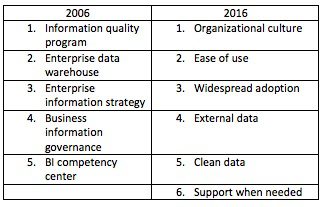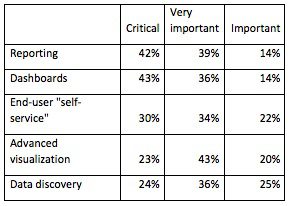Datamation content and product recommendations are
editorially independent. We may make money when you click on links
to our partners.
Learn More
While no one seriously disputes the value of business intelligence/analytics in business, government, education or other nonprofit organizations, the drivers of return on investment appear to be evolving. Comparing the results of three recent surveys to a 2006 poll, I found a few perennial drivers of analytics RoI/value, but other technologies or initiatives have become much more important.
As you can see from the table listing the top BI/analytics drivers of RoI and value (in descending order of importance from the survey reports), the maturation of BI/analytics tools and their adoption rates over the past two decades led to a lesser role for IT management techniques as RoI drivers.

The six drivers of value in 2016 are based on an analysis of these surveys:
1. “The Wisdom of Crowds Business Intelligence Market Study” for 2016 by Dresner Advisory Services, with 1,524 respondents.
2. “The Untapped Power of Self-Service Data Analytics,” by Harvard Business Review Analytics Services, with 644 respondents.
3. “Analytics and decision making,” by HBR AS, with 827 respondents.
The five drivers of BI value from 2006 were reported by a Businessweek Research Services survey and report with 359 respondents.
Note that I am using the Dresner survey definition of successful use of BI/analytics as the measure of value/RoI, while the analytics and decision making report by HBR AS uses revenue gains over the past two years. HBR AS found that more than half of best-in-class analytics users claimed revenue growth of more than 10% over the past two years, compared to less than a third of the analytics laggards. While correlation is not necessarily causation, there are clear indications that organizations that have adopted these six drivers have delivered a significant RoI.
It’s all about culture
These days the organization’s culture is the most important driver of value/RoI from analytics. A top-down, data-driven culture where the CEO, his or her direct reports and all of their subordinate managers make decisions based on data, leavened with experience but avoiding gut instinct, will create demand for, and use of, analytics tools.
Of course, if those tools aren’t easy to use then the data driven culture will be stymied. These days, self- service tools that enable end users to easily analyze data are considered vitally important to analytics/BI success and therefore RoI. The firms most successful at getting value from BI/analytics have “gotten the IT department out of business of satisfying requests,” notes Howard Dresner, founder and chief research officer of Dresner Advisory Services and a 27-year veteran of BI market watching. “Some tools allow you to do that.”
Indeed, self-service tools were the third highest rated technology driving success according to the Dresner survey, followed closely by advanced visualization. In my opinion, advanced visualization is another way of making analytics easier to use, by enabling users to find insights from the data. Note in the following table that these two relatively new technologies ranked higher than more than a dozen other and older technologies.

However, not everyone should have access to everything, of course. “We don’t want to give everybody a data discovery tool,” Dresner explains. “Self-service differs with user. Sales people in the field don’t need a discovery tool. Management needs to understand what they need.”
A data driven culture supported by easy-to-use tools will encourage widespread use. Use won’t be limited to just a few top executives and a handful of math-literate managers in the finance department crunching revenue and profitability data. Dresner found that penetration is close to half at successful organizations, while 70% of unsuccessful analytics organizations have penetration rates of less than 10%.
“BI success comes when the CEO drives it within the organization,” says Dresner. “The C-levels have to be up to their eyeballs in this and then it filters down. Managers in the lines of business or otherwise in the middle of the organization are strong influencers. They can see the parochial value having more perspective.”
A relatively recent newcomer to the key RoI drivers of analytics is incorporating external data into decision-making systems. Not just web traffic logs to measure potentially lost customer traffic, but industry and government data, weather forecasts and a myriad of other sources. One of the HBR AS surveys found that access to external data was an important for ROI as internal data.
The demand for external data gives the issue of clean data new life. Inaccurate, obsolete or other data quality horrors haunted BI implementations for decades, but Dresner and others see the stabilization of enterprise systems (ERP, CRM, SCM and others) as reducing the chaos. Indeed, his survey found that more than half of the respondents now have a common view of enterprise data.
In fact, the improvement in the quality of internal data, and the rising importance of external data, provides a great opportunity for the traditional IT department. “Organizations have made great strides in improving internal sources of data,” Dresner adds. The complexity presented by external data sources is an opportunity for IT, he says.
“There are a lot of gotchas to using external data. It becomes incumbent for IT to certify data sources,” Dresner says. “In addition, the role of IT, through its data fluency, is to know how to combine different external data sources. And at that point IT can create a brand around high quality corporate data. Also, IT should educate users in working with external sources that may be beyond IT control.”
However, relatively few IT organizations are satisfying user needs for external data. More than six out of 10 analytics users polled in one of the HBR AS studies said they typically rely on IT or a data analytics group to support the data analysis. Yet less than a fifth were very or extremely satisfied with IT’s ability to compile internal and external data. Not surprisingly, less than a fifth were very satisfied with the speed or quality of IT support of analytics, too.
Just imagine the RoI and success rates of analytics if IT can close the gap on user satisfaction with IT support.
-
Huawei’s AI Update: Things Are Moving Faster Than We Think
FEATURE | By Rob Enderle,
December 04, 2020
-
Keeping Machine Learning Algorithms Honest in the ‘Ethics-First’ Era
ARTIFICIAL INTELLIGENCE | By Guest Author,
November 18, 2020
-
Key Trends in Chatbots and RPA
FEATURE | By Guest Author,
November 10, 2020
-
Top 10 AIOps Companies
FEATURE | By Samuel Greengard,
November 05, 2020
-
What is Text Analysis?
ARTIFICIAL INTELLIGENCE | By Guest Author,
November 02, 2020
-
How Intel’s Work With Autonomous Cars Could Redefine General Purpose AI
ARTIFICIAL INTELLIGENCE | By Rob Enderle,
October 29, 2020
-
Dell Technologies World: Weaving Together Human And Machine Interaction For AI And Robotics
ARTIFICIAL INTELLIGENCE | By Rob Enderle,
October 23, 2020
-
The Super Moderator, or How IBM Project Debater Could Save Social Media
FEATURE | By Rob Enderle,
October 16, 2020
-
Top 10 Chatbot Platforms
FEATURE | By Cynthia Harvey,
October 07, 2020
-
Finding a Career Path in AI
ARTIFICIAL INTELLIGENCE | By Guest Author,
October 05, 2020
-
CIOs Discuss the Promise of AI and Data Science
FEATURE | By Guest Author,
September 25, 2020
-
Microsoft Is Building An AI Product That Could Predict The Future
FEATURE | By Rob Enderle,
September 25, 2020
-
Top 10 Machine Learning Companies 2020
FEATURE | By Cynthia Harvey,
September 22, 2020
-
NVIDIA and ARM: Massively Changing The AI Landscape
ARTIFICIAL INTELLIGENCE | By Rob Enderle,
September 18, 2020
-
Continuous Intelligence: Expert Discussion [Video and Podcast]
ARTIFICIAL INTELLIGENCE | By James Maguire,
September 14, 2020
-
Artificial Intelligence: Governance and Ethics [Video]
ARTIFICIAL INTELLIGENCE | By James Maguire,
September 13, 2020
-
IBM Watson At The US Open: Showcasing The Power Of A Mature Enterprise-Class AI
FEATURE | By Rob Enderle,
September 11, 2020
-
Artificial Intelligence: Perception vs. Reality
FEATURE | By James Maguire,
September 09, 2020
-
Anticipating The Coming Wave Of AI Enhanced PCs
FEATURE | By Rob Enderle,
September 05, 2020
-
The Critical Nature Of IBM’s NLP (Natural Language Processing) Effort
ARTIFICIAL INTELLIGENCE | By Rob Enderle,
August 14, 2020
SEE ALL
APPLICATIONS ARTICLES









